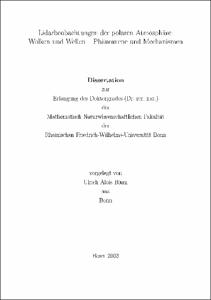Lidarbeobachtungen der polaren AtmosphäreWolken und Wellen – Phänomene und Mechanismen

Lidarbeobachtungen der polaren Atmosphäre
Wolken und Wellen – Phänomene und Mechanismen

| dc.contributor.advisor | Lübken, Franz-Josef | |
| dc.contributor.author | Blum, Ulrich Alois | |
| dc.date.accessioned | 2020-04-06T12:21:15Z | |
| dc.date.available | 2020-04-06T12:21:15Z | |
| dc.date.issued | 2003 | |
| dc.identifier.uri | https://hdl.handle.net/20.500.11811/1953 | |
| dc.description.abstract | Since 1997 the Bonn University Institute of Physics operates a Rayleigh/Mie/Raman lidar on the Esrange near the Swedish city of Kiruna north of the Arctic circle. During seven winter and six summer campaigns a large amount of cloud and temperature observations were obtained in the polar middle stratosphere. The temperature observations of the U. Bonn lidar regularly show waves superposed on the temperature porfiles. An analysis of these atmospheric gravity waves reveals strong wave activity during winter and little wave activity during summer. This seasonal variability can be understood in terms of the dominant wind regimes in the troposphere and stratosphere. A continuous decrease in the potential energy density of the gravity waves is observable since 1997. During winter polar stratospheric clouds (PSC) are frequently observed. PSCs play a key role in the polar stratospheric chemistry which leads to the formation of the ozone hole. The existence of these clouds depends crucially on atmospheric temperatures, which determine the PSC types formed. An analysis of the occurrence of PSCs regarding the types and synoptical temperatures disclose that most of the observed PSCs need additional cooling to below synoptic scale temperatures for formation. Dynamically induced cooling is provided by the large gravity wave activity observed in the winter temperature data. | en |
| dc.language.iso | deu | |
| dc.rights | In Copyright | |
| dc.rights.uri | http://rightsstatements.org/vocab/InC/1.0/ | |
| dc.subject | Atmosphäre | |
| dc.subject | Stratosphäre | |
| dc.subject | PSC | |
| dc.subject | Dynamik | |
| dc.subject | Schwerewellen | |
| dc.subject.ddc | 520 Astronomie, Kartografie | |
| dc.title | Lidarbeobachtungen der polaren Atmosphäre | |
| dc.title.alternative | Wolken und Wellen – Phänomene und Mechanismen | |
| dc.type | Dissertation oder Habilitation | |
| dc.publisher.name | Universitäts- und Landesbibliothek Bonn | |
| dc.publisher.location | Bonn | |
| dc.rights.accessRights | openAccess | |
| dc.identifier.urn | https://nbn-resolving.org/urn:nbn:de:hbz:5n-02954 | |
| ulbbn.pubtype | Erstveröffentlichung | |
| ulbbnediss.affiliation.name | Rheinische Friedrich-Wilhelms-Universität Bonn | |
| ulbbnediss.affiliation.location | Bonn | |
| ulbbnediss.thesis.level | Dissertation | |
| ulbbnediss.dissID | 295 | |
| ulbbnediss.date.accepted | 01.12.2003 | |
| ulbbnediss.fakultaet | Mathematisch-Naturwissenschaftliche Fakultät | |
| dc.contributor.coReferee | Hilger, Erwin |
Files in this item
This item appears in the following Collection(s)
-
E-Dissertationen (4350)




